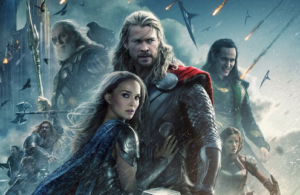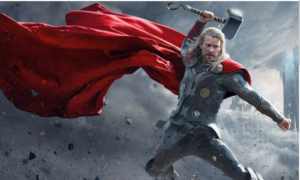Introduction:
Released in 2013 as the second installment in the Thor film series within the Marvel Cinematic Universe (MCU), “Thor: The Dark World” is a captivating tale that delves into the cosmic and mystical realms of the Marvel universe. Directed by Alan Taylor, the film follows the God of Thunder, Thor, as he faces a new and formidable adversary, Malekith the Accursed, and confronts a powerful force known as the Aether. While the film received mixed reviews, its significance in expanding the MCU’s narrative and introducing key elements cannot be overlooked.

Plot Overview:
The story begins with the convergence, a rare cosmic event that aligns the Nine Realms. As the boundaries between worlds weaken, Malekith, the leader of the Dark Elves, seeks to unleash the Aether, a destructive force capable of plunging the universe into darkness. Thor, portrayed once again by Chris Hemsworth, must team up with his adoptive brother Loki, played by Tom Hiddleston, to thwart Malekith’s sinister plans and save the realms from impending doom.
Character Dynamics:
One of the strengths of “Thor: The Dark World” lies in its exploration of character dynamics, particularly the complex relationship between Thor and Loki. Tom Hiddleston’s portrayal of the mischievous and enigmatic Loki adds depth to the narrative. The film delves into Loki’s internal struggles and showcases the evolving dynamic between the two brothers, combining elements of rivalry, betrayal, and reluctant cooperation.
Natalie Portman reprised her role as Jane Foster, a brilliant astrophysicist and Thor’s love interest. Jane becomes inadvertently linked to the Aether, making her a target for Malekith. The film explores the challenges of balancing a superhero life with personal relationships, adding a human touch to the larger-than-life Marvel universe.

Visual Spectacle and Cosmic Realms:
“Thor: The Dark World” is celebrated for its visually stunning portrayal of the Nine Realms. From the grandeur of Asgard to the desolation of Svartalfheim, the film showcases diverse and captivating landscapes. The battle sequences, especially during the convergence, are a visual feast, combining CGI effects with intricate set designs to create an immersive experience for the audience.
Malekith and the Dark Elves:
Christopher Eccleston portrays Malekith the Accursed, the primary antagonist of the film. Malekith’s quest for the Aether and his desire to plunge the universe into darkness provide a menacing backdrop to the narrative. While the character received mixed reviews for being somewhat one-dimensional, Eccleston’s performance adds an element of gravitas to the Dark Elf leader.
The Aether and the Reality Stone:
“Thor: The Dark World” introduces the Aether, a powerful and mysterious substance later revealed to be one of the Infinity Stones – the Reality Stone. This connection ties the film directly to the overarching narrative of the MCU and sets the stage for the events of “Avengers: Infinity War” and “Avengers: Endgame.”
Conclusion:
“Thor: The Dark World” may not be the most universally acclaimed entry in the MCU, but its contributions to the larger narrative and character development make it an essential chapter in Thor’s journey. The film’s exploration of the cosmic realms, the dynamics between Thor and Loki, and the introduction of the Reality Stone all play crucial roles in shaping the MCU’s interconnected storytelling. As the Marvel universe continues to expand, “Thor: The Dark World” remains a key piece of the intricate puzzle that is the Marvel Cinematic Universe.

